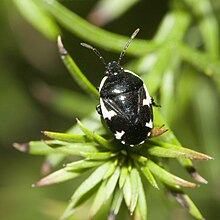Condylognatha
| Condylognatha | |
|---|---|

| |
| "Tritomegas sexmaculatus from Hemiptera. | |
| Scientific classification | |
| Kingdom: | Animalia |
| Phylum: | Arthropoda |
| Class: | Insecta |
| (unranked): | Paraneoptera |
| Superorder: | Condylognatha |
| Orders | |
| |
Condylognatha is a monophyletic grouping (superorder)[2] that contains Hemiptera (true bugs) and Thysanoptera (thrips). Condylognatha belongs to Paraneoptera, which include its sister group, lice (Psocodea).[3][4]
Taxonomy[]
Hemiptera and Thysanoptera are both the sister-groups based on morphological characters, and jointly known as Condylognatha.[5]
Hemiptera[]
Hemiptera /hɛˈmɪptərə/ is an order of insects most often known as the true bugs (cf. bug), comprising around 50,000–80,000 species of cicadas, aphids, planthoppers, leafhoppers, shield bugs, bed bugs and others. They range in size from 1 millimetre (0.039 in) to around 15 centimetres (5.9 in), and share a common arrangement of sucking mouthparts.
Thrips[]
Order Thysanoptera includes 5,500 species classified into two suborders distinguished by the ovipositor. Terebrantia have a well-developed conical ovipositor, while the Tubulifera do not. Instead the abdomen is drawn out in the shape of a tube. These insects are called thrips.
Phylogeny[]
| Condylognatha |
| ||||||||||||||||||||||||||||||
References[]
- ^ Truman, James W.; Riddiford, Lynn M. (2019). "The evolution of insect metamorphosis: A developmental and endocrine view". Philosophical Transactions of the Royal Society B: Biological Sciences. 374 (1783). doi:10.1098/rstb.2019.0070. PMC 6711285. PMID 31438820.
- ^ Grimaldi, David; Engel, Michael S.; Engel, Michael S.; Engel, Senior Curator and Professor Michael S. (May 16, 2005). Evolution of the Insects. Cambridge University Press. ISBN 9780521821490 – via Google Books.
- ^ Johnson, Kevin P.; Dietrich, Christopher H.; Friedrich, Frank; Beutel, Rolf G.; Wipfler, Benjamin; Peters, Ralph S.; Allen, Julie M.; Petersen, Malte; Donath, Alexander; Walden, Kimberly K. O.; Kozlov, Alexey M.; Podsiadlowski, Lars; Mayer, Christoph; Meusemann, Karen; Vasilikopoulos, Alexandros; Waterhouse, Robert M.; Cameron, Stephen L.; Weirauch, Christiane; Swanson, Daniel R.; Percy, Diana M.; Hardy, Nate B.; Terry, Irene; Liu, Shanlin; Zhou, Xin; Misof, Bernhard; Robertson, Hugh M.; Yoshizawa, Kazunori (December 11, 2018). "Phylogenomics and the evolution of hemipteroid insects". Proceedings of the National Academy of Sciences. 115 (50): 12775–12780. doi:10.1073/pnas.1815820115. PMC 6294958. PMID 30478043.
- ^ Johnson, Kevin P.; Dietrich, Christopher H.; Friedrich, Frank; Beutel, Rolf G.; Wipfler, Benjamin; Peters, Ralph S.; Allen, Julie M.; Petersen, Malte; Donath, Alexander; Walden, Kimberly K. O.; Kozlov, Alexey M.; Podsiadlowski, Lars; Mayer, Christoph; Meusemann, Karen; Vasilikopoulos, Alexandros; Waterhouse, Robert M.; Cameron, Stephen L.; Weirauch, Christiane; Swanson, Daniel R.; Percy, Diana M.; Hardy, Nate B.; Terry, Irene; Liu, Shanlin; Zhou, Xin; Misof, Bernhard; Robertson, Hugh M.; Yoshizawa, Kazunori (December 11, 2018). "Phylogenomics and the evolution of hemipteroid insects". Proceedings of the National Academy of Sciences of the United States of America. 115 (50): 12775–12780. doi:10.1073/pnas.1815820115. PMC 6294958. PMID 30478043.
- ^ Li, Hu; Shao, Renfu; Song, Nan; Song, Fan; Jiang, Pei; Li, Zhihong; Cai, Wanzhi (February 23, 2015). "Higher-level phylogeny of paraneopteran insects inferred from mitochondrial genome sequences". Scientific Reports. 5 (1): 8527. Bibcode:2015NatSR...5E8527L. doi:10.1038/srep08527. PMC 4336943. PMID 25704094.
- Insect superorders


